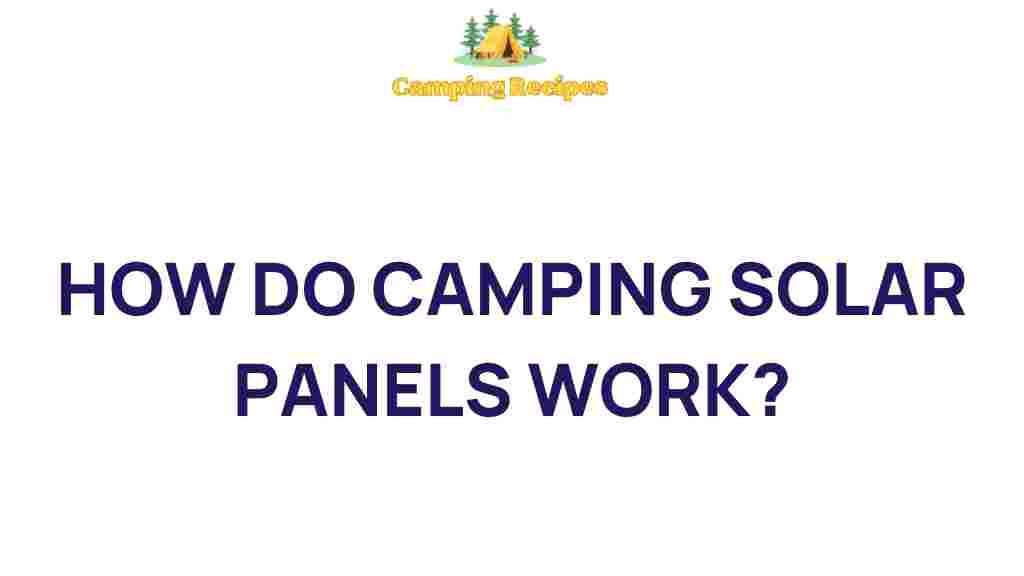Unveiling the Secrets: How Camping Solar Panels Work
As outdoor enthusiasts continue to seek innovative ways to enhance their camping experiences, camping solar panels have emerged as a game-changing solution for sustainable energy. This eco-friendly technology not only provides a reliable power supply but also aligns perfectly with the growing trend toward renewable energy. In this article, we will explore how camping solar panels work, their benefits, and essential camping tips for integrating this adventure technology into your outdoor gear.
The Basics of Camping Solar Panels
Camping solar panels are portable solar energy systems designed specifically for outdoor use. They harness the power of the sun to convert sunlight into electricity, which can then be used to charge devices, power lights, and run small appliances. Understanding their components and functionality is crucial for anyone looking to invest in this sustainable technology.
Components of Camping Solar Panels
Typically, camping solar panels consist of the following components:
- Solar Panels: These are the primary components that capture sunlight and convert it into electrical energy.
- Charge Controller: This device regulates the voltage and current coming from the solar panels to prevent overcharging the battery.
- Battery: A storage unit that holds the electricity generated by the panels for later use.
- Inverter: Converts the stored DC (direct current) electricity from the battery into AC (alternating current) electricity for use with standard devices.
How Camping Solar Panels Work
The process of generating electricity from camping solar panels can be broken down into several steps:
Step 1: Sunlight Absorption
When sunlight hits the solar panels, it is absorbed by the photovoltaic cells. These cells are typically made of silicon and are designed to convert sunlight into direct current electricity through the photovoltaic effect.
Step 2: Conversion to Electricity
As the solar panels absorb sunlight, the electrons in the silicon cells become excited and start to move. This movement generates direct current (DC) electricity, which is then sent to the charge controller.
Step 3: Regulation of Power
The charge controller plays a critical role in the system by regulating the flow of electricity to the battery. It ensures that the battery is charged efficiently and prevents overcharging, which can damage the battery.
Step 4: Storage in Battery
The electricity generated is stored in the battery, making it available for use even when the sun is not shining. This allows campers to draw power at night or during cloudy days, ensuring a constant power supply.
Step 5: Conversion to AC Power
When you need to power devices that require alternating current (AC) electricity, the stored DC electricity is sent to an inverter. The inverter converts DC power to AC power, enabling you to run a variety of devices, from smartphones to small refrigerators.
Benefits of Using Camping Solar Panels
Integrating camping solar panels into your outdoor adventures comes with numerous benefits:
- Sustainability: By relying on solar power, you reduce your carbon footprint and promote an eco-friendly lifestyle.
- Cost-Effective: While the initial investment may be higher, the long-term savings on fuel and energy costs can be significant.
- Convenience: Portable solar panels provide a reliable and convenient power supply for all your camping needs.
- Versatility: They can be used for various applications, including charging devices, running lights, and powering appliances.
Choosing the Right Camping Solar Panels
When selecting camping solar panels, consider the following factors:
- Power Output: Determine how much power you need based on your devices and gear. Look for panels with sufficient wattage to meet your requirements.
- Portability: Choose lightweight and compact panels that are easy to transport and set up.
- Durability: Opt for rugged designs that can withstand outdoor conditions, including rain, wind, and UV exposure.
- Charging Speed: Look for panels with efficient charging capabilities to maximize your energy harvest during daylight hours.
Camping Tips for Using Solar Panels
To make the most of your camping solar panels, keep these tips in mind:
- Proper Placement: Position your solar panels in a location with maximum sunlight exposure, ideally facing south in the Northern Hemisphere.
- Clean the Panels: Dust and debris can hinder performance. Regularly clean your panels to ensure optimal energy absorption.
- Monitor Battery Levels: Keep an eye on your battery levels to avoid running out of power unexpectedly.
- Use Energy Wisely: Prioritize essential devices and consider using energy-efficient appliances to extend your power supply.
Troubleshooting Common Issues
While camping solar panels are generally reliable, you may encounter some issues. Here are troubleshooting tips for common problems:
Problem 1: Low Power Output
If your solar panels are not generating enough power, check the following:
- Ensure they are positioned in direct sunlight.
- Inspect for dirt or debris on the panels that may obstruct sunlight.
- Check connections and cables for any damage or loose connections.
Problem 2: Battery Not Charging
If your battery is not charging, consider these points:
- Verify that the charge controller is functioning correctly.
- Check the battery for damages or wear.
- Ensure that the solar panels are producing power.
Problem 3: Inverter Issues
If devices are not powering up, the inverter may be malfunctioning. Troubleshoot by:
- Checking the inverter’s power switch and connections.
- Inspecting for any error codes on the inverter display.
- Consulting the inverter’s manual for specific troubleshooting steps.
Conclusion
Investing in camping solar panels is a step toward embracing a more sustainable and eco-friendly lifestyle while enjoying the great outdoors. By harnessing the power of the sun, you can ensure a reliable power supply for all your camping needs, making your adventures more enjoyable and hassle-free. With the right knowledge and equipment, you can fully integrate this innovative adventure technology into your outdoor gear.
For more information on renewable energy solutions, check out this resource. If you are looking for additional camping tips and gear recommendations, visit our blog.
This article is in the category Gear and created by CampingRecipes Team
